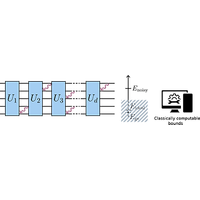Abstract
Quantum computers and simulators can potentially outperform classical computers in finding ground states of classical and quantum Hamiltonians. However, if this advantage can persist in the presence of noise without error correction remains unclear. In this paper, by exploiting the principle of Lagrangian duality, we develop a numerical method to classically compute a certifiable lower bound on the minimum energy attainable by the output state of a quantum circuit in the presence of depolarizing noise. We provide theoretical and numerical evidence that this approach can provide circuit-architecture-dependent bounds on the performance of noisy quantum circuits.
1 More- Received 20 July 2023
- Revised 14 February 2024
- Accepted 29 March 2024
DOI:https://doi.org/10.1103/PRXQuantum.5.020317
Published by the American Physical Society under the terms of the Creative Commons Attribution 4.0 International license. Further distribution of this work must maintain attribution to the author(s) and the published article's title, journal citation, and DOI.
Published by the American Physical Society
Physics Subject Headings (PhySH)
Popular Summary
The problem of finding ground states of classical and quantum Hamiltonians emerges in both many-body physics and computer science. Fault-tolerant quantum computers can provide an advantage over classical algorithms in solving this problem in certain scenarios, but they have yet to be realized in practice. In the meantime, noisy intermediate-scale quantum devices are being considered for finding ground states. It has thus become important to understand when the noise in such devices can potentially inhibit any computational advantage of quantum algorithms for ground states over classical ones. We provide a numerical method to classically compute provable bounds on the performance of quantum circuits with a constant rate of depolarizing noise. Our bounds account for the gates making up a circuit and perform better than previous approaches that are insensitive to the circuit architecture.
We formulate our bounds by utilizing Lagrangian duality and the fact that depolarizing noise decreases the purity of the quantum state through the circuit. When accounting for the trace purity of the state, we show that our bound can be computed efficiently using a matrix product operator ansatz. We use this method to classically compute performance bounds on one- and two-dimensional quantum circuits with qubits for the problem of finding ground states of spatially local Hamiltonians.
We expect our method to be an invaluable tool for experimentalists to study whether they can expect a quantum advantage in their platform and foresee its large-scale numerical implementation and application to current experiments. We also expect that extension of our method to continuous-time evolution would allow its application to analog quantum simulators.



